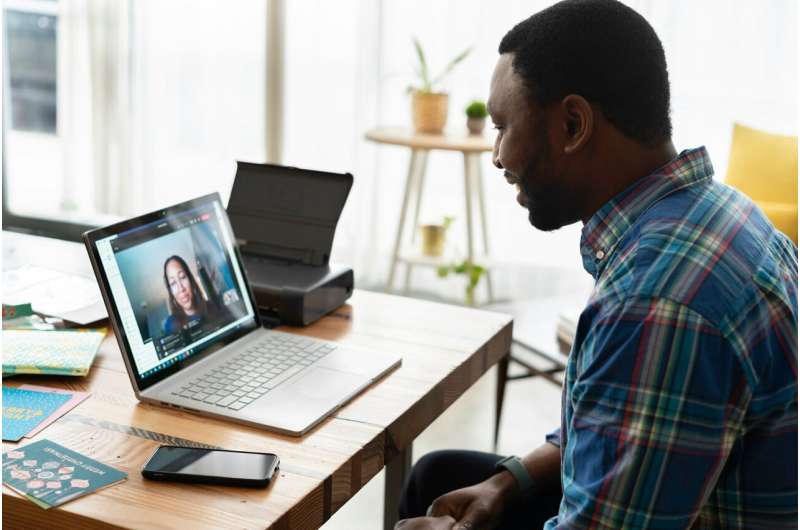This article has been reviewed according to Science X's editorial process and policies. Editors have highlighted the following attributes while ensuring the content's credibility:
fact-checked
peer-reviewed publication
trusted source
proofread
Q&A: Research reveals tips for making positive first impressions on co-workers, customers and clients

First impressions are often long-lasting and can impact a professional career in profound and unintended ways. Today, because initial business contacts often happen online—think an emailed intro, a phone text, or a Zoomed teleconference—many individuals form first impressions through these media.
Andrew Brodsky, assistant management professor at Texas McCombs, with Hayley Blunden of American University, recently conducted a literature review of 124 studies on virtual impressions and how people make them. He offers a wealth of research-based suggestions on how to put your digital best foot forward.
The review is published in the Journal of Management.
The subject is part of Brodsky's larger research interests that focus on individual work-based tech use and communication, with a particular interest in workplace virtual communication. This interview with him has been edited for length and clarity.
Why are virtual impressions important in the workplace?
Impressions can be really sticky. When you first meet someone, you form a variety of impressions: "How smart are they? They seem like a hard worker. They seem like someone you're going to like. Are they a good leader or not?"
Very often, these initial impressions can last for a long time and color how you view someone's behavior later. If you have a negative first impression, you might see something they do later in a more negative light, because your brain works to confirm its preexisting thought.
First impressions in business contexts are particularly important. Interviews are first impressions. When you reach out to a potential customer or client, they're going to get first impressions, which help determine whether they respond to your email or whether they decide to buy your product.
How do you see this research benefiting employers?
It can help people be more objective in how they evaluate their employees. Oftentimes, people evaluate each other's performance based on: "Do I want to get a beer with this person? Do I like this person?"
We don't realize that we're making those biased evaluations. So, one of the things researchers can do is help employers or managers or executives understand how they are forming impressions and why those impressions are biased.
Second, for those employers who are interested in training and helping employees improve, this is a good framework for providing guidance about how to make a better impression with customers and co-workers.
What about for employees?
When someone's working virtually or remotely, the only way their boss gets to see them or observe them is through their online interaction. That impression you create, through how you communicate and what you communicate, becomes that much more important.
But now, pretty much every employee—at least to some degree—communicates virtually, whether they're in the office or not. Even restaurant workers or grocery store workers are often getting schedules via email or via text, or they're communicating with their manager via text message. So, the idea of virtual workplace communication is not limited to office jobs anymore.
What does research say about using emoticons and emojis in workplace communication?
We found that there were mixed outcomes. On one hand, they often increased feelings of warmth and likeability. On the other hand, when it came to perceptions of intelligence, it was perhaps negative, because it made the person seem less intelligent or competent. So, it's nuanced. They make us more likable but risk making us seem less intelligent.
A less obvious source of virtual impressions is the time people take to reply to an email. What did your review show?
Timely responses matter. Being slow to reply has been shown to decrease perceptions of trust and competence.
That said, you can relax a bit, as research also shows that people overestimate how quickly they need to respond to messages. The takeaway is that you should aim for a happy medium.
There doesn't seem to be a benefit to rushing to reply to emails the second you receive them, but you also don't want to delay for too long. The studies that showed response time matters tended to have delays of one day or more, which suggests no meaningful negative consequences for that timing.
Based upon research to date, how do virtual workplace interactions measure up?
Managers and organizations often assume that virtual interactions lack social information and make it hard for others to build strong impressions. This has been one of the arguments often used by executives against remote work.
However, our review of the research shows that strong impressions—whether they're related to trust, competence, or likability—can often be built in brief virtual-only interactions. It's not that virtual interactions are uniformly lacking as compared to in-person interactions, but, rather, that they are just different.
More information: Hayley Blunden et al, A Review of Virtual Impression Management Behaviors and Outcomes, Journal of Management (2024). DOI: 10.1177/01492063231225160
Journal information: Journal of Management
Provided by University of Texas at Austin




















